 German Reich (1943)
German Reich (1943)
SPG – 662-753 Built
The greatest strength of the German Panzer Divisions during World War II was their rapid speed and ability to engage the enemy with concentrated force. But, sometimes, this was not enough, and additional firepower was needed to soften designated targets. This was the job of the Panzer Division’s own towed artillery. This was not always possible, as the mechanized towed and horse-drawn artillery could not always keep up with the advancing Panzers. They also needed time to properly set up for firing and were prone to enemy return artillery fire.

A more suitable solution was a tank-based self-propelled artillery vehicle. This was not possible to achieve in the early stages of the war, as the German tank industry was barely keeping up with the demand for tanks. It was not until 1942 that the first proper steps were undertaken in developing such vehicles. While initially, dedicated vehicle designs were considered, due to a lack of time, the Germans went for a stopgap solution. Originating from this, two different designs would emerge: the larger 15 cm armed Hummel and the smaller 10.5 cm armed Wespe. While intended as interim solutions, both would be built in relatively great numbers and used up to the end of the war.
History
During the early stages of World War II, German Army officials were aware that having mobile self-propelled artillery that could keep up and support the Panzer Divisions was desirable, but no major attempt was made in that direction. There were a number of reasons why this was never implemented during the first few years of the war or before it. One fact was that the German industry was unable to produce enough tanks, let alone have spare production capacity for other projects. The Luftwaffe provided the Panzer Divisions with adequate close operational fire support to compensate for the lack of a mobile artillery vehicle.
From 1940 to 1942, there were a number of different but limited attempts to build such vehicles. These included the Panzer I and Panzer II-based self-propelled vehicles equipped with the 15 cm sIG 33 infantry gun, which were built in small numbers. French captured tanks and tracked artillery tractors were also modified for this role. As these were built on captured chassis and without the possibility of mass-producing necessary parts, these would be built in smaller numbers and their use would be limited. Smaller numbers of British Vickers Light Tanks were modified with 10.5 cm guns and saw some use on the Eastern Front.
By 1942, it was obvious that the development of self-propelled artillery was urgent, as the Luftwaffe was losing control of the skies. For this reason, in the same year, Wa Prüf 6 (the office of the German Army’s Ordnance Department responsible for designing tanks and other motorized vehicles) issued requests for a new self-propelled artillery vehicle.

The initial request may have been somewhat overcomplicated, as it was requested that the new vehicle should have a full 360° firing arc (something that no other self-propelled artillery had during the war). The second major request was that it should have had the possibility of removing its main weapon and using it in a static emplacement. The Germans had a few such projects in development, like the ones based on the Panzer IV chassis (the Heuschrecke, for example). However, these would take too much valuable time to be properly developed and adopted for production. So, the German High Command (Oberkommando des Heeres-OKH) decided to proceed with a simpler solution for the time being. The so-called Zwischenlösung (interim solution) was to include chassis and other components that were already in production and available. After a short deliberation, in mid-July 1942, a decision was made by a Panzercommision to reuse the Panzer II Ausf.F chassis for this purpose. The Panzer II tank was already obsolete and used mostly in the reconnaissance role. Its chassis was also being reused for the Marder II anti-tank project.
To design this new vehicle, a contract was awarded to Rheinmetall-Borsig and Alkett. The Panzer II Ausf.F chassis had to be modified by moving the engine to the center of the vehicle, thus making room for a rear fighting compartment. It was to be lightly protected and armed with a 10.5 cm howitzer. When the vehicle was completed and tested, a report was presented to Hitler, in which it was noted that this modification was feasible to enter production by the end of July 1942.


Name
The first official name given to this vehicle was Leichte Feldhaubitze 18/2 (Sf) auf Geschützwagen II, dated from July 1943. During its service life, the vehicle received several slightly different designations. These included G.W. II ‘Wespe’ für le.FH 18/2 (Sf) auf Gw II from August 1943, Geschützwagen II in November 1943, leichte Panzerhaubitze auf Sd.Kfz.123 in May 1944, and le.F.H.18/2 auf. Fgst.Pz.Kpfw.II (Sf) (Sd.Kfz.124) in October 1944.
The name by which this vehicle is best known, Wespe (wasp), was actually only a suggestive name that was officially discontinued after February 1944. For the sake of simplicity only, this article will use the Wespe designation.
Production
For the production of the Wespe, FAMO (Fahrzeug und Motorenwerke GmbH) factories, located in Breslau, and the Ursus (which was also part of FAMO) ones from Warsaw were chosen. FAMO was already involved in Panzer II and Marder II production, so it possessed the production capabilities necessary for the new project. According to the German Army production plans for this project, some 1,000 vehicles were to be built by May 1944. After that, better designed mobile artillery was to replace it, something which never happened.
The first two production vehicles would be built by FAMO in February 1943. In order to speed up the production of the Wespe, the Marder II production would be terminated. The FAMO main production line at Breslau would be included in Wespe production up to August 1943, after which it was to focus solely on the production of the large Sd.Kfz.9 half-tracks. Following this decision, it was also decided to reduce the overall production order to 835 vehicles. With FAMO leaving the Wespe project, the only manufacturer remaining was Ursus. The total production price of each Wespe was 65,628 Reichsmarks (49,228 for the chassis and 16,400 for the gun).
| Monthly production in 1943 | |
| February | 2 |
| March | 40 |
| April | 136 |
| May | 37 |
| June | 34 |
| July | 59 |
| August | 57 |
| September | 49 |
| October | 37 |
| November | 38 |
| December | 38 |
| Monthly production in 1944 | |
| January | 37 |
| February | 33 |
| March | 35 |
| April | 19 |
| May | 20 |
| June | 19 |
| Total | 676 |
These production numbers are from T.L. Jentz and H.L. Doyle’s book, Panzer Tracts No.10-1 Artillerie Selbstfahrlafetten. As with many other German vehicles, production numbers differ between sources. Authors F. Koran and J. Starosta (Wespe in detail) list that 685 vehicles were built. According to author J. Engelmann (Wespe-Heuschrecke), 682 vehicles were built. Interestingly, author P. P. Battistelli (Panzer Divisions 1944-45) gives a production range between 662 and 753 being built.
The design
Hull
The Wespe was constructed using a heavily modified Panzer II chassis. Its hull consisted of the forward-mounted transmission, centrally positioned engine, and the rear fighting compartment for the crew and the main gun. The Wespe hull was slightly longer than the original Panzer II hull, by some 220 mm. Depending on the source, this lengthening was either introduced at the start of production or at some point in the later months of production.

Suspension
The suspension of the Wespe was, in essence, the same as that of the original Panzer II, with some changes implemented during the production. It consisted of five large 550 x 98 x 455 mm road wheels (on each side) which had rubber rims. Above each wheel, on a rocker arm, a quarter elliptical leaf spring unit with a movable roller was placed. With the addition of the new gun, more crew members, ammunition, and such, it led to an increase of the weight from 9.5 to 11 tonnes. To cope with this extra weight, the Wespe suspension was additionally strengthened by widening the leaf springs above the wheels.
There was also a front-drive sprocket (with a diameter of 755 mm), a rear positioned idler (650 mm diameter), and three return rollers (220 mm x 105 mm) on each side. The track had a width of 300 mm and consisted of 108 links. The ground pressure was 0.76 kg per square centimeter.

The first Wespes produced had the same bump stops as the original Panzer II. After only a few months of production, new stronger bump stops with vertical volute springs were added on the first two wheels on both sides. The vehicles produced after November 1943 had one more bump stop added to the last wheel. This was one of the few modifications added to the Wespe vehicles during production.

Engine and transmission
The Wespe’s engine was positioned in the center of the Panzer II Ausf.F hull. This was done to provide more working space for the crew and provide better stability during the firing of the gun. The powerplant was unchanged, using the same Maybach HL 62 TR 6-cylinder water-cooled engine giving 140 hp@2600 rpm. The two fuel tanks, with a total 170-liter capacity, were placed under the crew compartment. The maximum speed with this engine was 40 km/h and the cross-country speed was 20 km/h. The Wespe’s operational range was 140 km on good roads and 95 km cross-country. The engine and the crew compartment were separated by a 12 mm thick protective firewall.
As the engine was moved to the center, the drive shaft that connected it to the forward-mounted transmission system was shortened. The Zahnradfabrik SSG 46 type transmission had six forward and one reverse gears.
Superstructure
On top of the modified Panzer II hull, a new superstructure was placed. The front part of it consisted of a simple armored plate placed at a steep angle. On the left side, a fully enclosed driver compartment was added. The original prototype had a more rounded driver compartment cover. The actual production vehicles had a simpler three-sided design with angled armor. Some sources indicate that, during the production, both models of driver compartment design were used. This is false, as the round-shaped driver compartment was used only on the prototype vehicle. Interestingly, the surviving prototype vehicle has the production version of this compartment, which means that, at some point, it was changed.
On the sides of the driver’s compartment were two (one on each side) vision slits. In front, there was a square-shaped hatch that could be opened up. When his hatch was closed, the driver would use the front-mounted slit. All the slits were protected by a thick armored glass block. On top of the driver compartment, a two-piece escape door was placed. To have some access to the transmission, a round-shaped hatch (held in place by two bolts) was placed on the right side of the front superstructure plate.


The remainder of the superstructure covered the centrally positioned engine and served as a base for the rear crew compartment. On both sides, there were two cooling air grilles for the engines. The superstructure had mostly simple and flat sides. The central part of the superstructure sides curved slightly inward. Just behind the engine (toward the crew compartment to the rear), an opening for the gun mount was left.

Fighting compartment
To the rear of the vehicle, a new open-top fighting compartment was placed. It consisted of several armored plates bolted together. The two front plates were angled toward the gun and were additionally reinforced by the gun shield. The height of the side armor plates lowered to the back, mostly to reduce weight. To the rear, a rectangular-shaped door was placed. It could be easily lowered to provide more working room and easy access to additional spare ammunition from auxiliary vehicles. Inside the crew compartment, on both sides, there were a number of brackets for various equipment, such as the radio, fire extinguisher, canvas cover, MP submachine guns and their ammunition, etcetera. The radio and its aerial antenna were positioned on the left side of the fighting compartment. Shells were stored to the rear and the propellant on the sides inside the fighting compartment.



Armor
The Wespe was only lightly protected, but this was intentionally done in order to reduce the overall weight and speed up the production as much as possible. The armor thickness was also limited in order to not adversely affect the vehicle’s overall driving performance, as this was the main point of this new vehicle. The use of the Panzer II light tank chassis was another reason why the armor thickness had to be kept minimal, as the added weight could significantly affect its performance.
The front armor of the hull was 30 mm thick and placed at a 75° vertical angle. The sides were 14.5 mm thick, the rear 14.5 mm at 10° horizontal and the bottom was only 5 mm thick. The front superstructure armor was 15 (or 20 mm) thick and placed at a 30° vertical angle. The sides and rear of the superstructure were 15 mm and the top 10 mm thick. The fighting compartment was protected by only 10 mm thick all-around armor. The front armor was placed at 66°, side 73°, and rear 74° vertical angle.

The Wespe’s overall armor thickness was never intended to protect against direct hits, but mainly from small-caliber fire, shrapnel, etcetera. The Wespe’s greatest defense was its ability to quickly reposition to another firing position without any fear of returning enemy fire. A good camouflage was also handy for increasing its chances of surviving.

Armament
For the main weapon of the Wespe, the proven 10.5 cm le.F.H. 18/2 field howitzer was chosen. This was the most common field artillery piece that the German employed during the war. It was designed by Rheinmetall and put into service in 1930. The 10.5 cm le.F.H. 18 had good overall performance, but the range was somewhat lacking. For this reason, it was improved during the war in order to increase its range, mobility, and ease of production.

For the installation of the 10.5 cm le.F.H. 18/2 in the Wespe, the wheels, trails, and the shield were removed. The 10.5 cm le.F.H. 18/2 was then placed in the center of the vehicle, on a specially designed mount. The main weapon had an elevation of -5° to +42° and a traverse of 20° in both directions (or 17°, depending on the source). The maximum firing range, of 10,650 m, could be achieved by using the 14.8 kg heavy high-explosive round. To help with the recoil, the 10.5 cm le.F.H. 18/2 was provided with a muzzle brake. The barrel had to be replaced after firing 10,000 rounds. The Wespe’s uncomplicated construction made such a replacement an easy job, which could be achieved with a simple crane. For aiming the 10.5 cm le.F.H. 18/2, the gunner would use the Rblf 36 gun sight. The recoil distance during firing was 1.15 m, with the maximum allowed being 1.17 m.
During long marches, the Wespe’s main gun could be locked in place by two travel locks. One was placed in front of the gun’s shield and one to the rear. The Wespe’s main weapon was flanked by two curved armored shields.





In some sources (like D. Nešić, “Naoružanje Drugog Svetsko Rata-Nemačka”), the main weapon of the Wespe is described as the le.F.H. 18M. This was actually a slightly improved version of the 10.5 cm le.F.H. 18. The 10.5 cm le.F.H. 18M introduced an improved recoil system, had a muzzle brake, and had a new type of long-range shell, but otherwise, it was the same artillery piece. The modified main gun of the Wespe and the 10.5 cm le.F.H. 18M are quite similar due to the muzzle brake and could have been easily misidentified as the same weapon.

The 10.5 cm le.F.H. 18/2’s two-part ammunition consisted of the shell and charge. There were three different types of shells that could be used. These included the standard High Explosive (HE), Armor Piercing (AP), and smoke rounds. The charges acted as the propellant for the shells, and there were six different types (marked as 1, 2, 3, etcetera), depending on the desired range.
Initially, the ammunition load consisted of 32 rounds and cartridges. This was officially changed to 30 rounds on 28th June 1943. Of these, 18 HE rounds had normal fuzes and 4 had double fuzes. The remaining 8 rounds were AP rounds. Regarding the charges, 45 were carried inside the vehicle. There were 30 cartridges in the 1-5 range and 15 additional 6 charge cartridges.
For close protection, the crew had at their disposal a 7.92 mm MG 34 or 42, and two 9 mm MP 38 submachine guns. But, given that these vehicles were supposed to act as artillery fire support vehicles from longer ranges, these would ideally be rarely used.

Crew
The Wespe had a crew of five, which included the commander, gunner, loader, radio operator, and driver. The driver was positioned in the front hull and was the only crew member that had all-around protection. The remaining crew were positioned in the fighting compartment. The gunner was located to the left of the main gun, with the radio operator behind him. The radio equipment consisted of a FuG Spr transmitter and receiver. Interestingly, authors G. Parada, M. Suliga, and W. Hryniewicki (Wespe Sd.Kfz 124) note that the gunners (possibly referring to the gunner and loader) were additionally trained in driving and operating the radio equipment, so that, in case of emergency, if the driver or the radio operator were unable to perform their duties, the other crew members could temporarily take over their roles. To the right of the gun were positioned the commander and the loader.

Due to the Wespe’s small size and cramped fighting compartment, the crews were left with no room to carry extra equipment and spare parts. There was not even room for their personal belongings. It was quite common to see external modifications, such as added storage boxes, spare tracks (although there were standard holders for spare track links on the lower front hull), road wheels, and all sorts of other equipment that the crew may have needed.

Organization
The Wespes were mainly issued to the Panzer or Panzer Grenadier Divisions of the German Army, but also in some quantities to the SS Panzer Divisions. Six artillery vehicles plus two ammunition Wespes were used to form a Batterie (Battery) which was allocated to the Artillery Regiment of the Panzer Divisions. On average, each Panzer Division would have 12 Wespes while, in rarer cases, some had 18 vehicles (for example, the 3rd Panzer Grenadier Division). These would be further reinforced by a battery of six 15 cm Hummel self-propelled guns.

The first distribution to units
For the upcoming German Kursk Offensive, six divisions were to be equipped with Wespes by the end of May 1943. These included the 17th Panzer Division with 12 vehicles, the 3rd and 29th Panzer Grenadier Divisions, each with 18, Panzer Grenadier Division Grossdeutschland with 12, SS Das Reich with 12 and the LSSAH also with 12 Wespes. The following month, 9 more Divisions were supplied with Wespes. By the end of 1943, over 30 Armored Divisions would be equipped with Wespes, with the majority having 12 and, in rare cases, 6 or 18 vehicles.
In Combat
The Wespe first saw combat action during the German offensive at Kursk in 1943. As the German progress was slow, the Wespes were mostly employed as static artillery support elements. But, thanks to their mobility, they could easily avoid any return artillery fire and minimize their losses.
While not intended to engage tanks other than in an emergency, the Wespes could repel such an attack under ideal circumstances. Such a thing happened some 50 km northwest of Orel, when a group of 8 Soviet tanks tried to overrun a Wespe battery. The Wespe crews opened fire at ranges of over 1.5 km, targeting the Soviet tanks with a mix of AP and HE rounds. Due to the rapid artillery fire, the Soviet tanks decided to abort their attack and retreated without losses.
Not many problems were noted by the crews of the Wespes, with one of the few being the wear of the teeth in the steering gear. There were also problems with oil leaks in the drive housing unit. By the end of 1943, very few Wespes were lost in combat. Of the over 30 Divisions which employed them, only a few had less than 10 operational vehicles, with most being at full strength or close to it.
In Italy, the Wespe performed somewhat more poorly, but this was mainly due to the terrain. In a report made by an unnamed German officer, who was sent to Italy to examine the Wespe’s performance on this front, he noted that the terrain was the Wespe’s greatest enemy:
“….The planned employment of the Sfl.-Artillerie (self-propelled artillery) within a Panzer Division practically never occurred in Italy. This was due to the peculiarity of the terrain and the combat situation. In actual fact, the Sfl. were preponderantly employed in platoons or only as individual guns. Therefore, in no way were useful experiences obtained on the tactical employment of the Sfl. ..”
He also noted several problems with the Wespe that were a consequence of the difficult terrain. These included engines that were too weak and unable to effectively overcome the steep terrain, the final drive units often broke, and that there were a number of breakdowns of other parts like brakes, brake linings, etcetera. He also mentioned that the 3rd Panzer Grenadier Division had 11 vehicles operational out of 18, while the 26th Panzer Division had only 2 operational out of 12. The Wespe would also participate in the battle for France in 1944. In March 1945, there were still some 307 operational Wespes.



Geschützwagen II für Munition
The lack of a tracked ammunition supply vehicle was something that the Germans never managed to solve completely. In the case of the Wespe (and the larger Hummel), they came up with a simple solution. What the Germans did was simply reuse the Wespe chassis by removing the gun to provide room for spare ammunition. The gun opening on the fighting compartment was simply covered with a sheet of metal. This modified vehicle was able to carry some 90 rounds of ammunition. These vehicles could be repurposed back into mobile artillery vehicles quite quickly. The crew consisted of a driver and two additional crew members responsible for ammunition resupply. Between June 1943 and June 1944, some 159 such vehicles would be built.

Surviving Wespes
Today, there are a few surviving Wespes in the world. There is one Wespe in the Munster Panzer Museum in Germany. This particular vehicle is actually the first prototype. Another one is in the Russian Patriot Park Museum and one more is at the Saumur Musée des Blindés in France.

There are also a number of Wespe wrecks, like the one at the Battle of Normandy Museum in France. In Germany, there is one at the Westwall Museum at Pirmasens. Two more are in Andre Becker’s private collection in Belgium.
Conclusion
Despite being designed as a temporary solution until properly designed self-propelled artillery vehicles would be introduced, the Wespe proved to be a successful vehicle. It provided the German armored units with a fire support vehicle that was able to keep pace with them. While less than 700 were produced, these were widely distributed to various armored Divisions. They were not perfect and had a number of issues, mostly related to their original intended design as a temporary solution and the use of an old lightweight chassis. As the Wespe was meant to be quickly pushed into production, some things, like the working room and armor, had to be sacrificed.
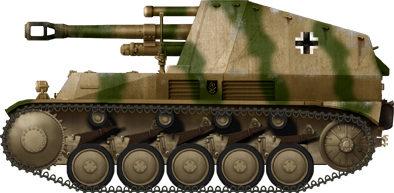
Wespe from the 2nd Panzerartillerie Regiment, Russia, June 1944 – HD picture.
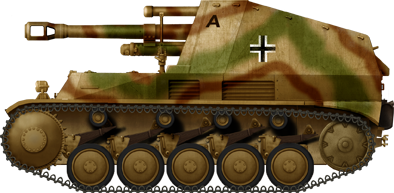
Wespe from the 146th Panzer Artillerie Regiment, PanzerLehr Regiment, Normandy, summer 1944.
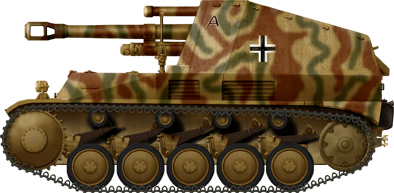
Wespe from the 1st Abteilung, Panzerartillerie regiment, 8th Panzerdivision, Ukraine, summer 1944.
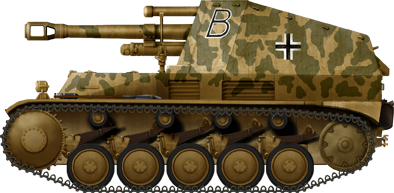
Wespe from an unidentified unit, Italy, summer 1944.
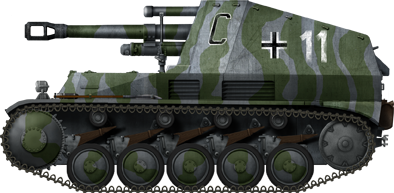
Wespe from an unidentified Abteilung, perhaps part of the Hermann Göring Panzer Division, Anzio, January 22, 1944.
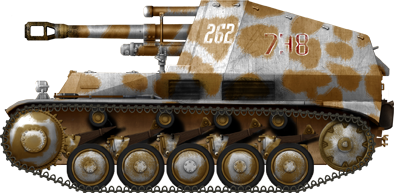
Wespe of an unidentified unit, Hungary, March 1945.
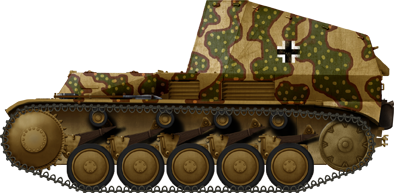
Munitionschlepper auf Wespe, Fallschrimpanzerdivision Hermann Göring, East Prussia, winter 1944-45.
le.F.H.18/2 auf. Fgst.Pz.Kpfw.II (Sf) (Sd.Kfz.124) |
|
| Dimensions (L-W-H) | 4.81 m x 2.28 m x 2.3 m, |
| Total weight, battle-ready | 11 tonnes |
| Crew | 5 (Commander, Gunner, Loader,Driver and Radio operator) |
| Propulsion | Maybach HL 62 TR 140 HP @ 3000 rpm |
| Speed (road/off-road) | 40 km/h, 20 km/h |
| Range (road/off-road)-fuel | 140 km, 95 km |
| Primary Armament | Armament:10.5 cm le.F.H18/2 |
| Secondary Armament | One 7.92 mm M.G.34 machine guns |
| Elevation | -5° to +42° |
| Armor | 5 mm – 30 mm |
Sources
- G. Parada, M. Suliga and W. Hryniewicki, Wespe Sd.Kfz 124, Kagero .
- P. P. Battistelli (2009) Panzer Divisions 1944-45 Osprey Publishing
- F. Koran and J Starosta (2000) Wespe in detail, Wing and Wheels Publication.
- D. Nešić, (2008), Naoružanje Drugog Svetsko Rata-Nemačka, Beograd
- A. Lüdeke (2007) Waffentechnik im Zweiten Weltkrieg, Parragon books
- J. Engelmann (1980) Wespe-Heuschrecke, Podzun-Pallas-Verlag
- P. Chamberlain and H. Doyle (1978) Encyclopedia of German Tanks of World War Two – Revised Edition, Arms and Armor press.
- D. Doyle (2005). German military Vehicles, Krause Publications
- T.L. Jentz and H.L. Doyle, Panzer Tracts No.10-1 Artillerie Selbstfahrletten
- W. Oswald (2004) Kraftfahrzeuge und Panzer, Motorbuch Verlag.
- R. Hutchins (2005) Tanks and other fighting vehicles, Bounty Book.


2 replies on “10.5 cm leFH 18/2 (Sf.) auf Fahrgestell Panzerkampfwagen II ‘Wespe’ (Sd.Kfz.124)”
Great article. One correction. The suspension section states the Wespe had 4 return rollers, it only ever had 3.
The last image for the Wespe in the German tank museum said “the surviving Wespe”, but right before that you state that there are a few left.